Password Manager Browser Extensions
Bitwarden browser extensions integrate password management directly into your favorite browser. Download a Bitwarden browser extension from your browser's marketplace or app store, or from the Bitwarden Downloads page.
Browser extensions are supported for the two most recent versions of Google Chrome, Mozilla Firefox, Opera, Microsoft Edge, and Safari. For Vivaldi, Brave, and Tor, only the most recent version is supported.
tip
The Safari browser extension is packaged with the desktop app, available for download from the macOS App Store. Learn more.
Let's start your Bitwarden browser extension journey by adding a new login item to your vault and making sure it's secure and easy to find:
Folders are a great way to make sure you can always find vault items when you need to use them. To create a folder:
Navigate to the Vault tab and select the New icon.
Choose which type of item to create (in this case, select Folder).
Give your folder a name (for example,
Social Media), and select Save.
Now let's add a login to your new folder. To create a new login item:
Navigate to the Vault tab and select the New icon.
Choose which type of item to create (in this case, select Login).
Enter the basic information for this login. For now, give the item:
An Item name to help you easily recognize it (for example, Instagram
Account).Your Username.
Your current Password (we will replace this with a stronger password soon).
Select a folder from the Folder dropdown. If you are following our example, choose the Social Media folder you just created.
tip
If you're using Bitwarden in your workplace, you can use the Owner dropdown to create this item within your organization instead of in your individual vault.
In the Website (URI) field, enter the URL where you log in to the account (for example,
https://instaagram.com/login).Nice work! Select Save to continue.
Now that you have saved a new login, let's improve its security by replacing your password with a stronger one:
In your web browser, login to the account with your existing username and password. We're going to be replacing your existing password with a stronger one, but this is a great opportunity to practice autofill!
To autofill, open the Bitwarden browser extension while you're on the website's login page and, in the Vault tab, select the Fill button for the suggested item: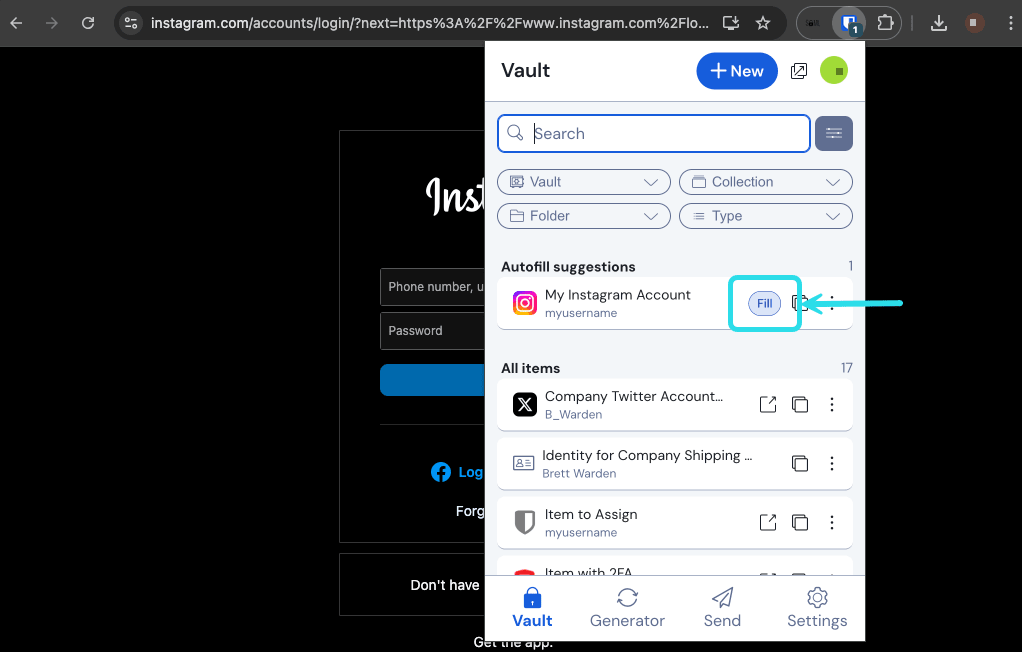
Autofill via browser extension Once logged in, find where you can change your password.
On the website's change password form, enter your Current Password, which you can copy and paste from Bitwarden using the Copy icon:

Copy a password Once your old password is filled in, open the login item in Bitwarden and select Edit.
In the Password box, select Generate and tweak your password settings to your liking. You can use to icon until you get a password you like and, once you do, select Use this password. Moving from
Fido1234toX@Ln@x9J@&u@5n##Bcan stop a hacker in their tracks.Select Save.
Copy your new password and paste it into the New Password and Confirm Password fields back on the website.
Congratulations! Your login is now saved in Bitwarden for secure and easy use!
Do you have multiple Bitwarden accounts, perhaps one for personal use and one for work? The browser extension can be logged in to five accounts at once!
To login to an additional account, select the currently logged-in account from the top-right corner of the browser extension:
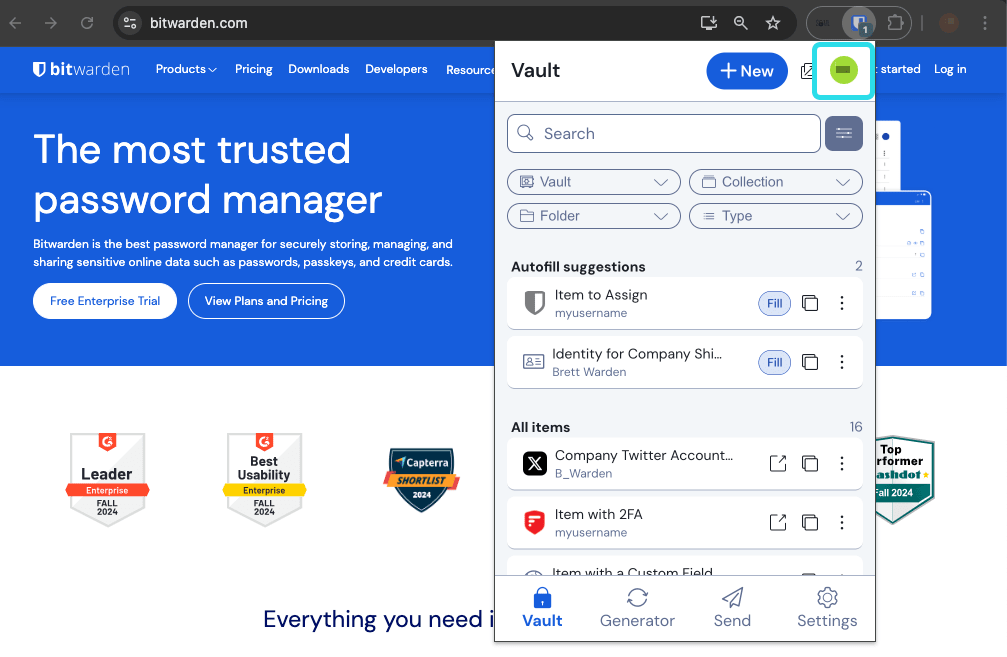
Once you have opened the account switching menu, select Add account:
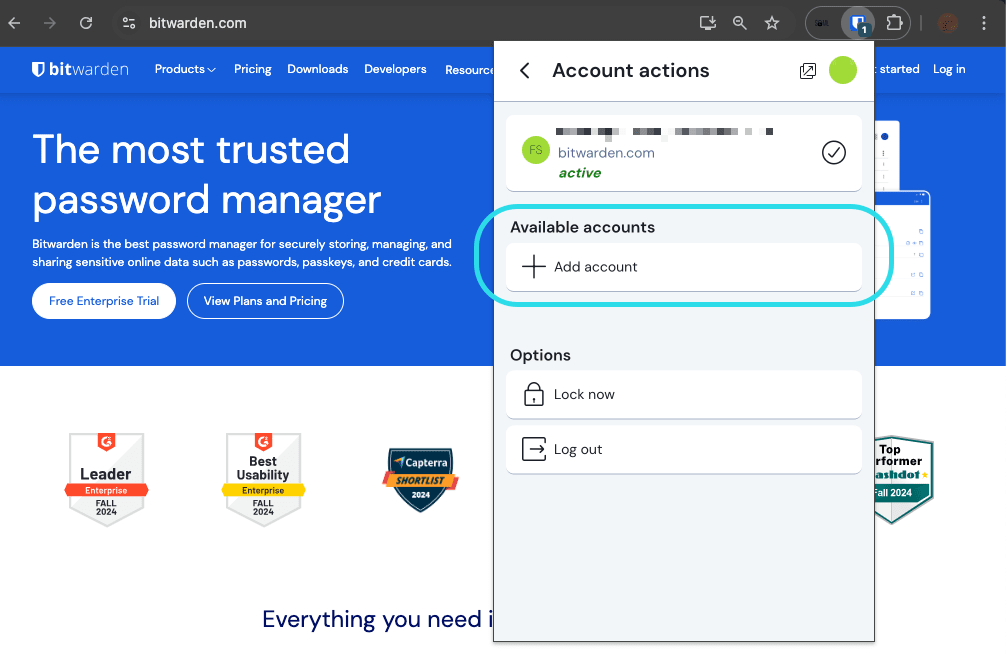
Once you log in to your second account, you can quickly swap between them from the same menu, which will also show the current status of each account's vault (locked or unlocked). If you log out of one of these accounts, it will be removed from this list.
note
Account switching on the browser extension is not available on Safari at this time.
Now that you have mastered the basics let's dig into one more action that you will take regularly, Autofill and Auto-save, and three recommended setup steps; easier vault unlocking, pinning the extension to your browser, and disabling the browser's built-in password manager:
There are lots of ways to autofill credentials with Bitwarden browser extensions! The basic method is to open the Bitwarden browser extension while you're on the website's login page and, in the Vault tab, select the Fill button for the suggested item:

Note that, when you have logins saved for a website you're trying to log in to, Bitwarden browser extensions will overlay a notification bubble reporting the number of logins you have for that website. Those items will appear at the top of your Autofill suggestions. You can filter what will appear in the suggestions and what's displayed in the All items list using the filter dropdown menus, which can be shown or hidden using the button:
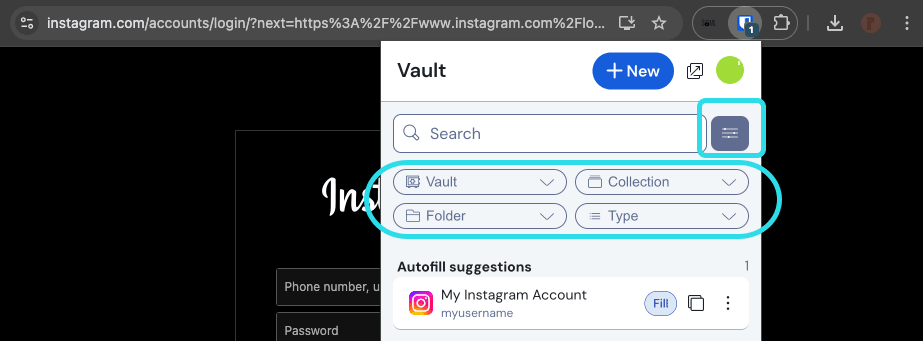
There are plenty of other methods and ways of customizing autofilling from your browser extension, including context menus and keyboard shortcuts. Learn more.
When you log in to a website without using autofill, Bitwarden will offer to remember logins if:
An item with that URI isn't in your vault.
An item with that URI is in your vault, but has a different username or password.
When you see this banner, select Save to add a new or updated login item with the username, password, and URI. You can also choose to Select folder... for the item if it's new, or Edit the item before saving:

If you're a member of an organization using the Remove individual vault policy, selecting Save will take you to a screen where you can choose which collection to add it to.
If you don't want to see these banners, open the browser extension's Settings tab, select Notifications, and uncheck the Ask to add login and Ask to update existing login boxes.
note
Did you know that you can save and autofill passkeys with the Bitwarden browser extension? Learn more about passkeys here.
For fast access to your credentials, setup a PIN or biometrics to unlock your vault. To setup a PIN, for example:
Open the Settings tab.
In the Account security section, check the Unlock with PIN checkbox.
Enter the desired PIN code in the input box. PIN codes can be any combination of characters (a-z, 0-9, $, #, etc.)
tip
Optional: The pre-checked option Ask for biometrics on launch will require you to enter your master password instead of a PIN when your browser restarts. If you want to be able to unlock with a PIN when you browser restarts, uncheck this option.
Pinning the browser extension will ensure that it's easily accessible each time you open your browser. The procedure differs based on which browser you are using:
Select the Extensions icon next to the address bar and select the Pin icon next to Bitwarden:

Right-click the Bitwarden browser extension and choose Pin to Toolbar. You can also activate a persistent Bitwarden sidebar by selecting View → Sidebar → Bitwarden from the Firefox menu.
note
If you do not want the Bitwarden sidebar to open on browser startup, select Close Sidebar from the Bitwarden tab on the Firefox sidebar. Users may be required to select Close Sidebar on each active Firefox tab and restart Firefox.
Right-click anywhere in the tool bar and select Customize Toolbar to open a drag-and-drop interface that lets you move or remove icons in your toolbar:
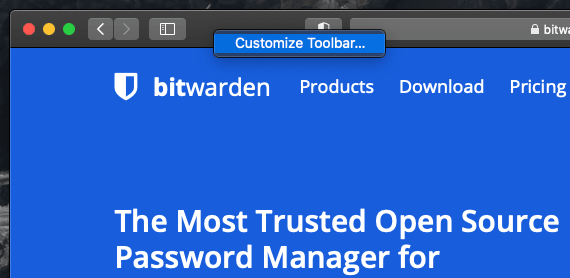
The Bitwarden browser extension has a pop-out feature that will allow you to reposition the client while using your internet browser. To pop-out the browser extension, select the icon shown in the following screenshot:

The browser extension will not observe to your chosen vault timeout settings when popped-out.
Most web browsers will automatically save your passwords by default, but experts generally agree that built-in password managers are more vulnerable than dedicated solutions such as Bitwarden:
In Chrome or any Chromium-based browser (Edge, Opera, and Brave), navigate to the Passwords page by entering chrome://password-manager/settings in the address bar, substituting chrome for your browser name (for example, brave://password-manager/settings). For Edge users, navigate to edge://wallet/settings.
On this page, toggle off both the Offer to save passwords option and the Auto Sign-in option:
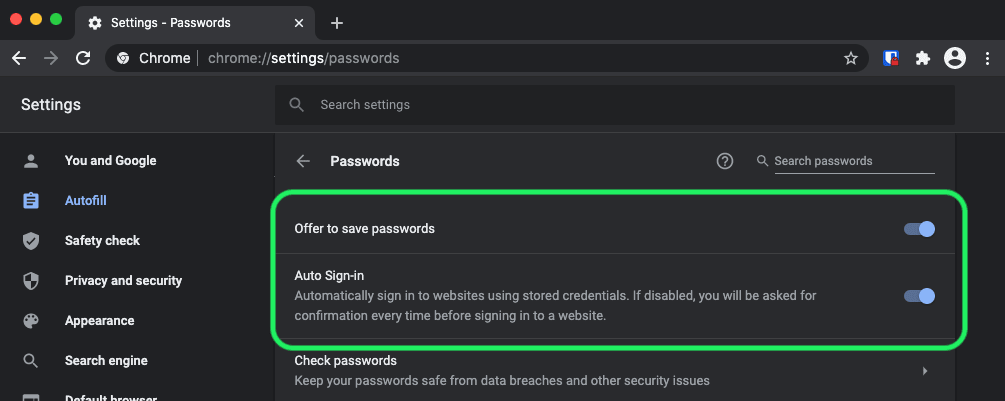
This page will also list any Saved Passwords that are being stored by the browser:

If you haven't already saved these passwords in Bitwarden, export them to prepare for future import to Bitwarden. Once exported, you should delete these passwords from the browser's storage.
In Firefox, navigate to Preferences → Privacy & Security and scroll down to the Logins and Passwords section. In this section, uncheck all the pre-checked options:
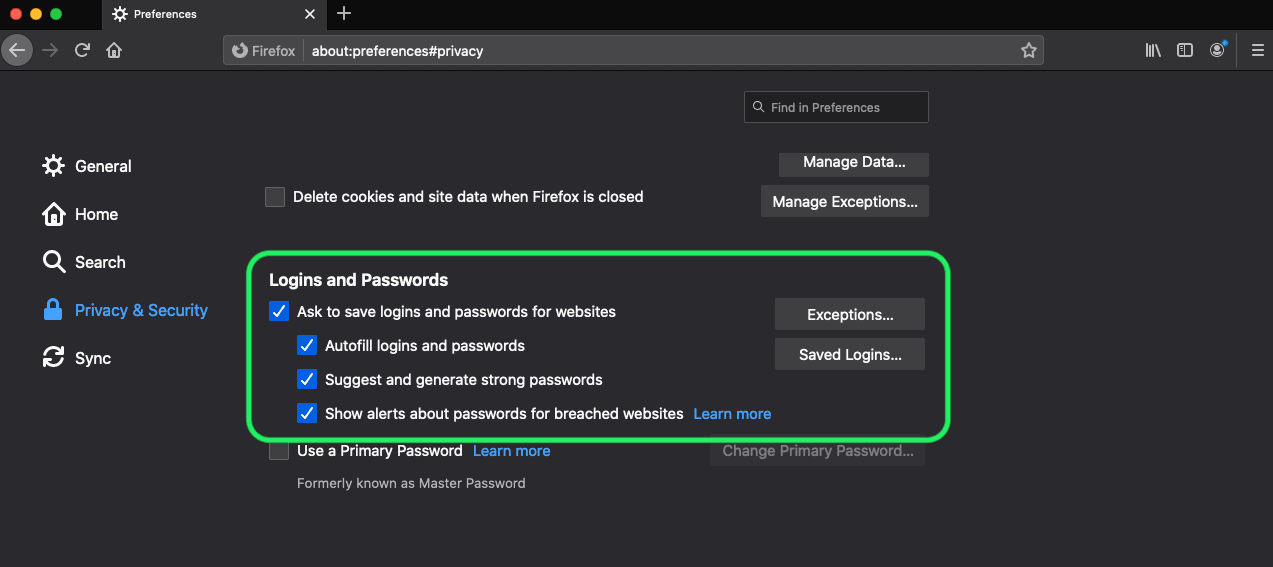
tip
Bitwarden Password Manager offers a variety of reports for premium users, like the Exposed Passwords and Reused Passwords reports, and a free Data Breach report for all users.
You should also find out which logins Firefox has already saved by selecting the Saved Logins... button:

If you haven't already saved these passwords in Bitwarden, export them for future import to Bitwarden. Once exported, you should Remove these passwords from Firefox.
In Safari, open Preferences from the menu bar and navigate to the AutoFill tab. On this tab, uncheck all the pre-checked options:

You should also find out which passwords Safari has already saved by navigating to the Passwords tab:

If you haven't already saved these passwords in Bitwarden, create login items in Bitwarden for these passwords. Once all saved passwords are in Bitwarden, Remove these passwords from Safari.
In Vivaldi, open the Vivaldi Settings window and select Privacy from the left-hand navigation. Scroll down to the Passwords section and uncheck the Save Webpage Passwords option:
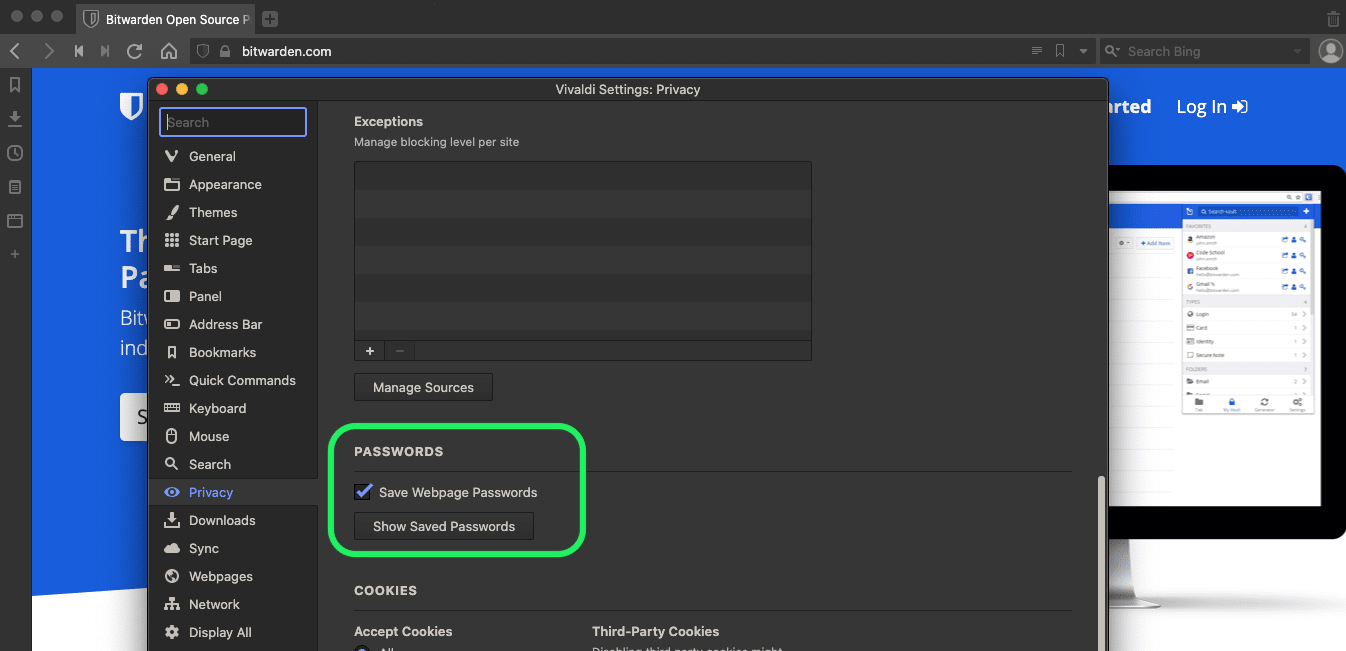
You should also find out which passwords Vivaldi has already saved by selecting the Show Saved Passwords button:
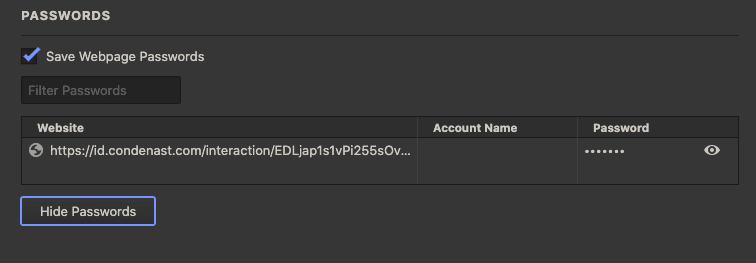
If you haven't already saved these passwords in Bitwarden, create login items in Bitwarden for these passwords. Once all saved passwords are in Bitwarden, remove these passwords from Vivaldi. Learn how.
Despite sharing roots with Firefox, Tor is unique in that it doesn't save your logins by default. If you haven't manually configured Tor to save and autofill logins, you are already all set.
If you did, navigate to the Passwords page by entering about:preferences#privacy in the address bar, and scroll down to the Logins and Passwords section. Toggle off all the options that you had checked:

You should also find out which logins Tor has already saved by selecting the Saved Logins... button:
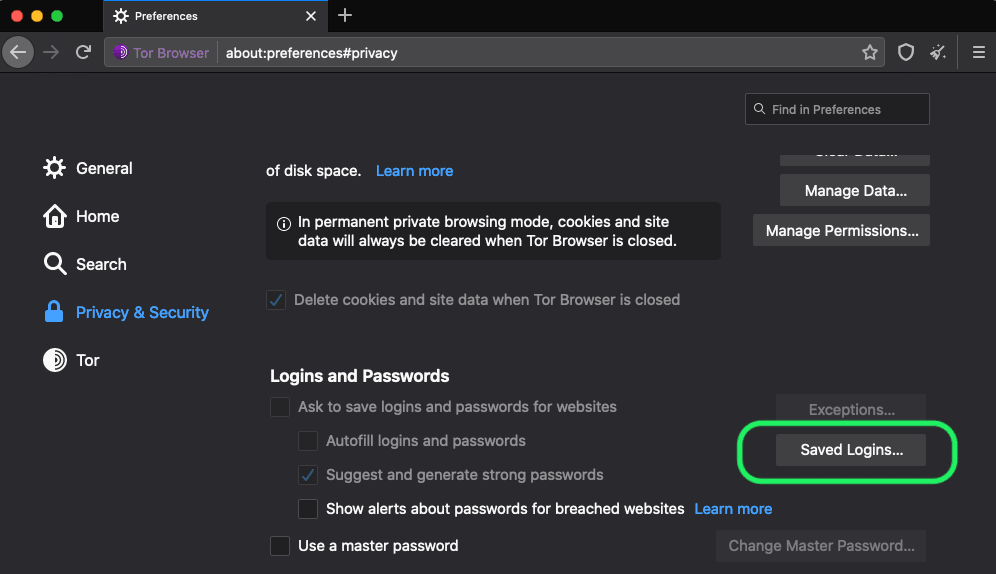
If you haven't already saved these passwords in Bitwarden, create login items in Bitwarden for these passwords. Once all saved passwords are in Bitwarden, Remove these passwords from Tor.
In DuckDuckGo, navigate to Settings → Autofill. From this screen, uncheck the box for Usernames and passwords.
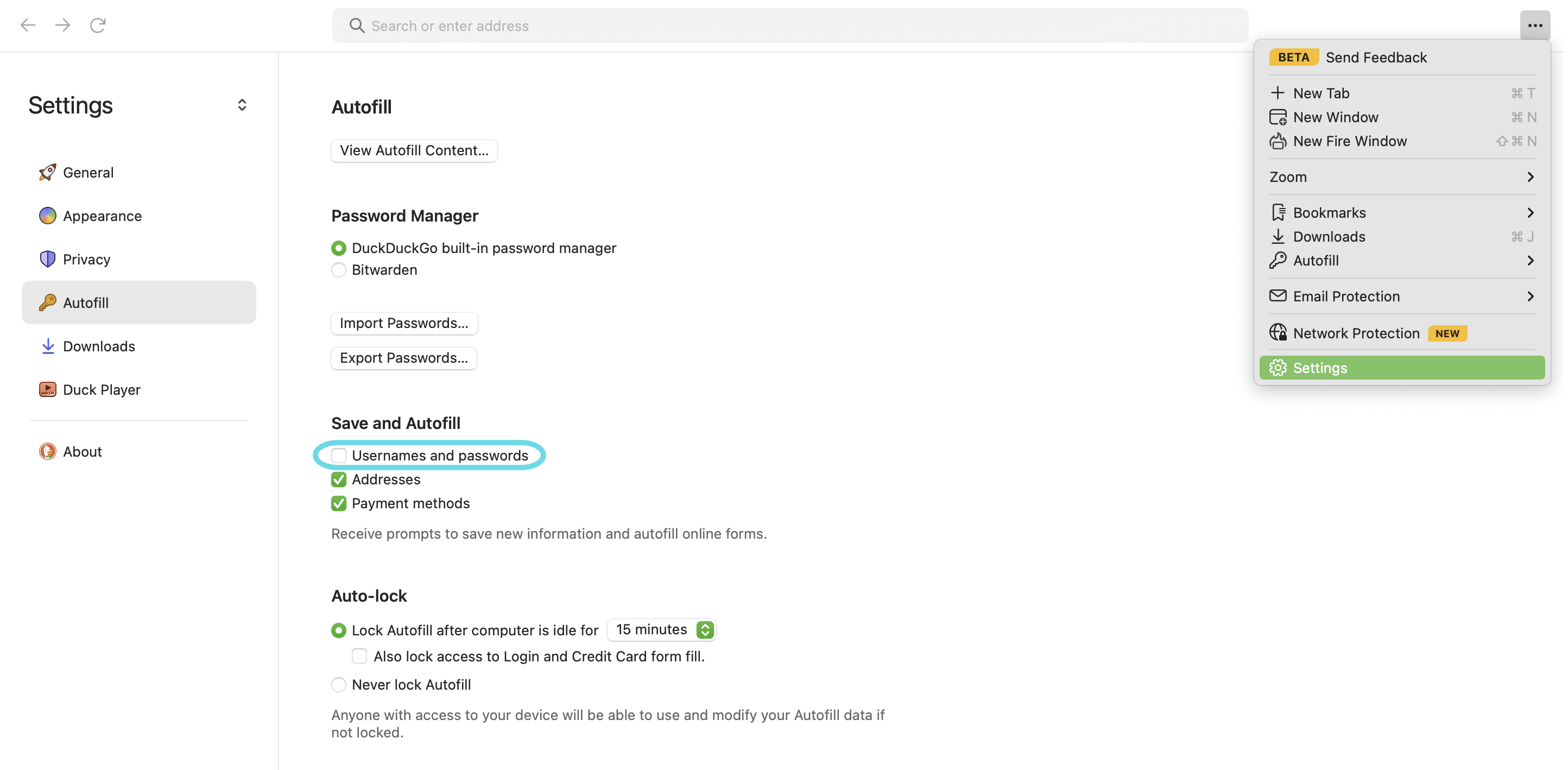
You can create a backup of your existing data by selecting Export Passwords. Once you have created a backup file, select View Autofill Content... and delete the stored autofill data to remove previously saved suggestions.
In the Password Manager section, macOS users can choose to use Bitwarden. Learn more about the Bitwarden DuckDuckGo macOS browser integration here.
Suggest changes to this page
How can we improve this page for you?
For technical, billing, and product questions, please contact support